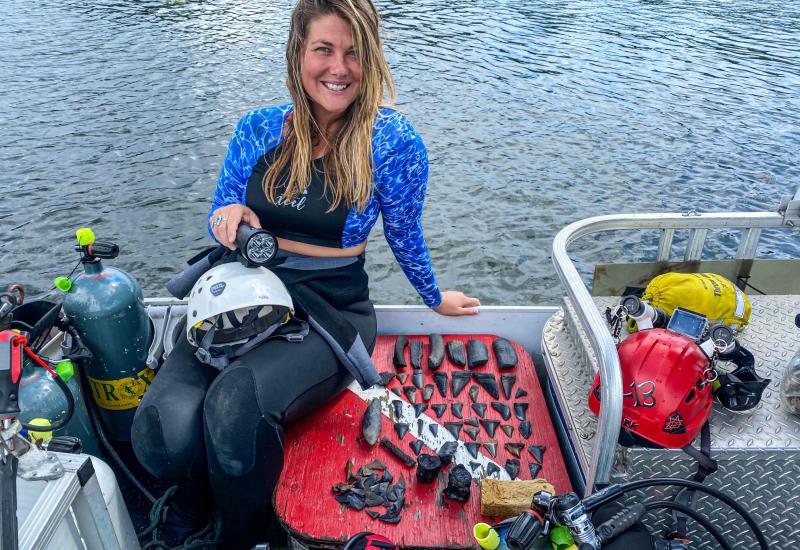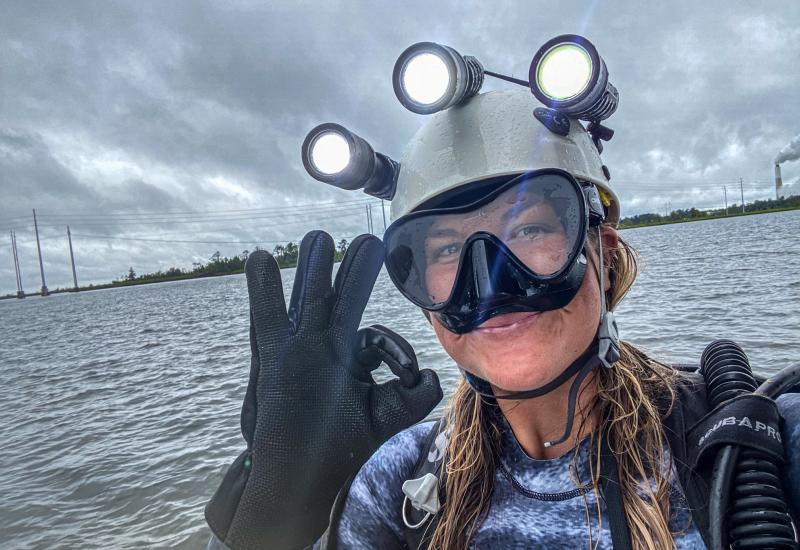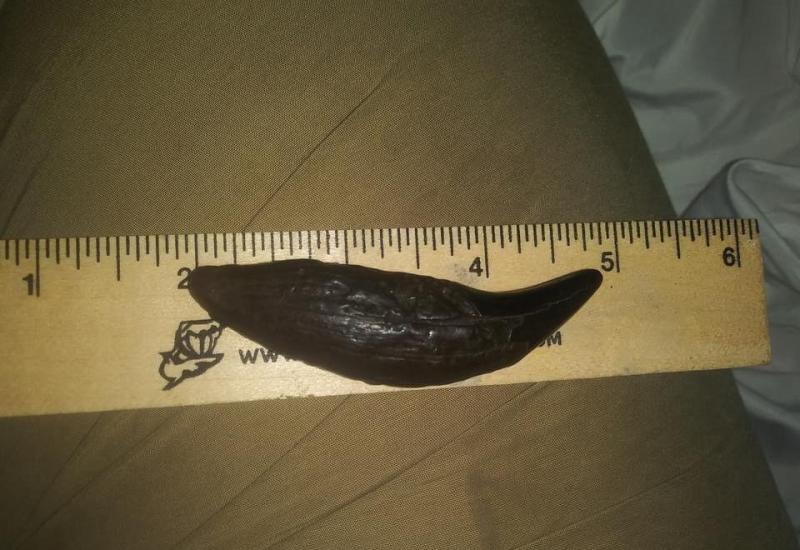Flower Garden Banks National Marine Sanctuary
January 2008
By Jesse Cancelmo
We were moored in exceptionally calm blue water almost seven hours' run time from Freeport, Texas. It was the last scheduled trip of the summer season and divers were suiting up for the first dive of a two-day trip with hopes of seeing "something big." Just 30 minutes into exploring the coral-covered mountain known as West Flower Garden, we got it. First one diver, then another, turned to point at an extremely large shadow moving overhead. Manta ray sightings are common year-round in the Flower Garden Banks National Marine Sanctuary, but to our surprise and delight, it was a whale shark that swam into view, slowly and silently moving its way past our group. That's the Flower Gardens for you--reliably good, and always with the power to surprise.
Located 70 to 115 miles off the coasts of Texas and Louisiana, the Flower Garden Banks is a trio of coral ridges thriving atop geologic salt domes that protrude from the 200- to 400-foot depths of the Gulf of Mexico. By a happy accident of geology, these pinnacles are just far enough south to support thriving hard-coral reefs, sponges and Caribbean reef fish; just shallow enough (they top out at 55 feet) to be accessible to recreational divers; and just far enough from shore to remain uncrowded and unspoiled. They were discovered and given their name in the early 1900s by fishermen who snagged their nets on the coral heads, bringing up colorful sponges along with abundant catches of snapper and grouper. The East and West Flower Garden Banks became a national marine sanctuary in 1992, providing protection from anchoring, commercial fishing and the discharge of harmful materials. The third coral ridge--Stetson Bank--was added in 1996.
Covering more than 300 acres of Gulf bottom, these pinnacles are worthy of their protected status. They are, after all, the northernmost coral reefs on the North American continental shelf, though on your first dive here it would be easy to confuse the reefs with the Caribbean. At any of the 17 moored dive sites, you will find yourself swimming over dense, rolling hills of brain and star corals punctuated by sand patches and alleyways. As the only reefs for hundreds of miles, these pinnacles attract and concentrate all manner of marine life. Inside the nooks of coral heads live tiny tropicals, while pelagic hunters sweep in on the currents. Atop many of the coral mounds you'll see schools of brown chromis, a roving barracuda or two, bluehead wrasse and Bermuda chub. It's common to spot black-tip sharks, manta rays and loggerhead turtles year-round, and from January through March, large schools of scalloped hammerhead sharks and spotted eagle rays can be seen passing overhead. Though by no means guaranteed, there's always the chance of seeing a whale shark.
The third ridge, Stetson Bank, is located 30 miles inshore from the West Flower Garden Bank. It's a mere 800 feet long and 200 feet across at its crest, but don't let the small size fool you. Big things happen regularly at Stetson. Its southwest point is a known hangout for powerful silky sharks, not to mention southern stingrays and the much larger roughtail rays. On the north wall, more than a dozen siltstone spires, all of them covered by fire corals and sponges, host an impressive community of tropical reef fish, including spotted scorpionfish and a golden variety of smooth trunkfish that is only found in the sanctuary's waters. But for my money, the most impressive display of undersea life on Stetson Bank is the finger coral formation near buoy number three. Banded coral shrimp, flamefish and spotted morays hide out in the nooks and pockets of the reef, while swarms of brilliant red creolefish hover over the lush green coral in a striking contrast of colors.
Thanks to the abundance of hard corals, particularly on the East and West Flower Garden Banks, the sanctuary is one of the best places in the world to witness the spectacle of the annual mass coral spawning. Each summer, seven to ten days after the August full moon, the reefs at the Flower Garden Banks literally erupt, simultaneously releasing BB-size sacs of eggs. In what looks like a reverse snowstorm, the spawn gradually floats to the surface, forming musty mats of nascent coral polyps that drift away on the current. Some float to faraway places, some become food, and some take root right here, growing in time to build the next generation of coral colonies and adding to the surprising beauty of the Flower Garden Banks.
InDepth
Water conditions There are two dive seasons in the northwestern Gulf of Mexico. The summer season is May through October with mid-July to mid-September being the best time for flat seas. Winter diving runs February through April when water temps dip into the high 60s. Visibility at the East and West Flower Garden Banks ranges from 75 to 150 feet year-round, while vis at Stetson can be more than 100 feet in the summer, but drops to 40 to 60 feet in the winter months. Currents and surface conditions can be unpredictable this far out in the Gulf, making this a dive adventure best-suited for intermediate and advanced divers.
Location 70 to 115 miles off the coasts of Texas and Louisiana. The sanctuary is accessible by private boat or by live-aboards operating out of Freeport and Galveston.
Dive Operators Gulf Diving (www.gulf-diving.com) operates two live-aboard dive boats (M/V Spree and M/V Fling) from Freeport. M/V Fish-N-Diver (www.fishndivers.com) departs from Galveston.
For More Information Contact the Flower Gardens National Marine Sanctuary at http://flowergarden.noaa.gov; check out www.reef.org/sanctuaries/FGBNMS.html or pick up a copy of the soon-to-be-released book (February 2008), Texas Coral Reefs, published by Texas A&M Press.
January 2008
By Jesse Cancelmo
We were moored in exceptionally calm blue water almost seven hours' run time from Freeport, Texas. It was the last scheduled trip of the summer season and divers were suiting up for the first dive of a two-day trip with hopes of seeing "something big." Just 30 minutes into exploring the coral-covered mountain known as West Flower Garden, we got it. First one diver, then another, turned to point at an extremely large shadow moving overhead. Manta ray sightings are common year-round in the Flower Garden Banks National Marine Sanctuary, but to our surprise and delight, it was a whale shark that swam into view, slowly and silently moving its way past our group. That's the Flower Gardens for you--reliably good, and always with the power to surprise.
Located 70 to 115 miles off the coasts of Texas and Louisiana, the Flower Garden Banks is a trio of coral ridges thriving atop geologic salt domes that protrude from the 200- to 400-foot depths of the Gulf of Mexico. By a happy accident of geology, these pinnacles are just far enough south to support thriving hard-coral reefs, sponges and Caribbean reef fish; just shallow enough (they top out at 55 feet) to be accessible to recreational divers; and just far enough from shore to remain uncrowded and unspoiled. They were discovered and given their name in the early 1900s by fishermen who snagged their nets on the coral heads, bringing up colorful sponges along with abundant catches of snapper and grouper. The East and West Flower Garden Banks became a national marine sanctuary in 1992, providing protection from anchoring, commercial fishing and the discharge of harmful materials. The third coral ridge--Stetson Bank--was added in 1996.
Covering more than 300 acres of Gulf bottom, these pinnacles are worthy of their protected status. They are, after all, the northernmost coral reefs on the North American continental shelf, though on your first dive here it would be easy to confuse the reefs with the Caribbean. At any of the 17 moored dive sites, you will find yourself swimming over dense, rolling hills of brain and star corals punctuated by sand patches and alleyways. As the only reefs for hundreds of miles, these pinnacles attract and concentrate all manner of marine life. Inside the nooks of coral heads live tiny tropicals, while pelagic hunters sweep in on the currents. Atop many of the coral mounds you'll see schools of brown chromis, a roving barracuda or two, bluehead wrasse and Bermuda chub. It's common to spot black-tip sharks, manta rays and loggerhead turtles year-round, and from January through March, large schools of scalloped hammerhead sharks and spotted eagle rays can be seen passing overhead. Though by no means guaranteed, there's always the chance of seeing a whale shark.
The third ridge, Stetson Bank, is located 30 miles inshore from the West Flower Garden Bank. It's a mere 800 feet long and 200 feet across at its crest, but don't let the small size fool you. Big things happen regularly at Stetson. Its southwest point is a known hangout for powerful silky sharks, not to mention southern stingrays and the much larger roughtail rays. On the north wall, more than a dozen siltstone spires, all of them covered by fire corals and sponges, host an impressive community of tropical reef fish, including spotted scorpionfish and a golden variety of smooth trunkfish that is only found in the sanctuary's waters. But for my money, the most impressive display of undersea life on Stetson Bank is the finger coral formation near buoy number three. Banded coral shrimp, flamefish and spotted morays hide out in the nooks and pockets of the reef, while swarms of brilliant red creolefish hover over the lush green coral in a striking contrast of colors.
Thanks to the abundance of hard corals, particularly on the East and West Flower Garden Banks, the sanctuary is one of the best places in the world to witness the spectacle of the annual mass coral spawning. Each summer, seven to ten days after the August full moon, the reefs at the Flower Garden Banks literally erupt, simultaneously releasing BB-size sacs of eggs. In what looks like a reverse snowstorm, the spawn gradually floats to the surface, forming musty mats of nascent coral polyps that drift away on the current. Some float to faraway places, some become food, and some take root right here, growing in time to build the next generation of coral colonies and adding to the surprising beauty of the Flower Garden Banks.
InDepth
Water conditions There are two dive seasons in the northwestern Gulf of Mexico. The summer season is May through October with mid-July to mid-September being the best time for flat seas. Winter diving runs February through April when water temps dip into the high 60s. Visibility at the East and West Flower Garden Banks ranges from 75 to 150 feet year-round, while vis at Stetson can be more than 100 feet in the summer, but drops to 40 to 60 feet in the winter months. Currents and surface conditions can be unpredictable this far out in the Gulf, making this a dive adventure best-suited for intermediate and advanced divers.
Location 70 to 115 miles off the coasts of Texas and Louisiana. The sanctuary is accessible by private boat or by live-aboards operating out of Freeport and Galveston.
Dive Operators Gulf Diving (www.gulf-diving.com) operates two live-aboard dive boats (M/V Spree and M/V Fling) from Freeport. M/V Fish-N-Diver (www.fishndivers.com) departs from Galveston.
For More Information Contact the Flower Gardens National Marine Sanctuary at http://flowergarden.noaa.gov; check out www.reef.org/sanctuaries/FGBNMS.html or pick up a copy of the soon-to-be-released book (February 2008), Texas Coral Reefs, published by Texas A&M Press.










